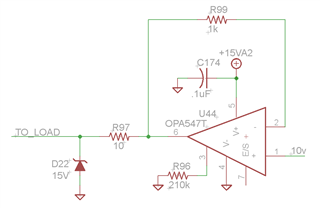Other Parts Discussed in Thread: STRIKE, OPA549
I have a design using the OPA547 that has a 10 ohm resistor in series with the output. This just to aid in stability. Anyway, the resistor is between the output of the amplifier and the external ESD protection diodes. With a heavy strike, the diodes may clamp the output at a few volts higher than the supply rail. For example, the supply rail is +15V, but the output could swing as high as 19V with a strong ESD event, so that leaves a current through the 10 ohm resistor of something in the neighborhood of 400mA. Most parts have a 10mA limit on their inputs and outputs due to limits on internal ESD protection diodes. How much momentary current can the output of this amp take with a strke like that? If possible, I prefer just a single TVS diode to ground instead of putting that ESD current into the rail, but that could go as high as 24V, or 900mA. Thoughts? Thanks.



